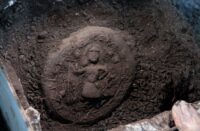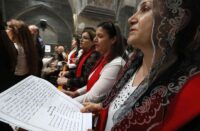
A remarkable pilgrimage road dating back to Jesus’ time was recently discovered in Jerusalem. Along the road, a podium was unveiled, where Peter addressed the crowds at Pentecost, introducing Jesus as the Messiah.
The latest excavations done at the City of David site unearthed an ancient street referred to as ‘the Pilgrimage Road’, which dates back to Jesus’ time and leads from the Shiloach Pool up to the entrances of the Temple. Alongside the ancient street, a podium used for addressing passers-by was unveiled. Archaeologists and historians are convinced that the street was used by the millions of pilgrims going up to the Temple year after year during the Holy Days mentioned in the Bible. One of those pilgrims being Jesus Himself.
During Shavuot (Jewish feast), also known as Pentecost, pilgrims from all over would gather in Jerusalem to thank God for the first fruits. A famous account of Shavuot can be found in Acts 2 — “The festival of Shavuot arrived, and the believers gathered together in one place”. According to the Gospels, during this gathering, the Holy Spirit was poured out. The sound of it was heard far and wide beyond the house.
Peter took the opportunity to explain what was going on and so he stood up with the Eleven, raised his voice and addressed the crowds… (Verse 14). In his speech, Peter introduces Jesus as the Messiah, being, as foretold, a descendant of the well-respected King David whose grave is here with us today (verse 29) in the nearby City of David, and after a fiery speech, the Gospel indicates that about 3 000 people were immersed (verse 41).
“The close proximity to the burial site of David, the dating and location of the ancient Pilgrimage Road, and the fact that baptism of 3 000 could only have taken place in the public “mikweh” of the Shiloach Pool, give us very strong indications that Peter and the Eleven addressed the crowds from such a podium unearthed right now,” states Moshe Gabay, licensed tour guide in Israel and Director of Keshet Journeys.
The Shiloach Pool, which is dated to Herod’s Period, was the largest public mikveh. Considering that the pools uncovered by the southern steps of the temple were private, the geographic aspects of the discovery in the nearby City of David could point to the event where the 3 000 were immersed right after Peter’s speech. (Acts 2 verse 41).
Gabay concluded that “While waiting for different times, and the return to our ‘temples’ (read: congregations) of today, this might be the opportunity to focus on the core and the mission of the Church. Realising the significance that God, through archaeology, reminds His people (in this case in the midst of the current pandemic) of the Church’s mission: sharing the Good News, that His Kingdom is at hand.
The city of David is working on opening these discoveries to the public, including the Pilgrimage Road along the podium and The Shiloach Pool, by the end of 2021 and to unite them to the current tour across the ancient city.
About The City of David
The story of the City of David began over 3 000 years ago, when King David left the city of Hebron for a small hilltop city known as Jerusalem, establishing it as the unified capital of the tribes of Israel. Years later, David’s son, King Solomon, built the First Temple next to the City of David on top of Mount Moriah, the site of the binding of Isaac, and with it, this hilltop became one of the most important sites in the world.
Today, the story of the City of David continues. Deep underground, the City of David is revealing some of the most exciting archaeological finds of the ancient world. While above ground, the city is a vibrant centre of activity with a visitor’s centre that welcomes visitors for an exciting tour to the site where much of the Bible was written.
The tour of the City of David begins with a breathtaking observation point overlooking biblical Jerusalem which sends visitors 3 800 years back in time to the days of Abraham, when the first foundations of the city were laid. As one moves through the site, one comes in contact with archaeological excavations and thrilling biblical finds that span thousands of years of history including both First and Second Temple Jerusalem.
The tour continues underground to the Gihon Spring, the major water source of Jerusalem for over 1 000 years. Visitors seeking adventure can trek through knee deep water in King Hezekiah’s 2 700-year-old water tunnel, one of the wonders of early engineering. Continuing to the Shiloach Pool, the major water drawing source in biblical times, one reaches the Herodian Road, the ancient thoroughfare that led pilgrims north to the temple.








Most interesting. Please explain why the City of David is Jerusalem, when Luke 2:11,15 designates it as Bethlehem.
Dear Hugh, that’s a good remark. In the Old Testament David calls Zion (Jerusalem) the City of David. 2. Samuel 5, 7 and David is buried in the Jerusalem the city he called the City of David in 1 King 2, 10. Peter speaks in Jerusalem on Pentecost and refers to David being buried there Acts 2, 29. Our point is that David was buried in ancient Jerusalem close to where the Podium was discovered. It is an additional support to the theory that from this podium Peter may have addressed the crowed.
The New Testament calls Bethlehem the City of David as Bethlehem is the birthplace and hometown of David. I believe both cities can be seen as the City of David.